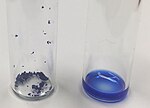Type a search term to find related articles by LIMS subject matter experts gathered from the most trusted and dynamic collaboration tools in the laboratory informatics industry.

In organic chemistry, thioketones (from Ancient Greek θεῖον (theion) 'sulfur';[1] also known as thiones or thiocarbonyls) are organosulfur compounds related to conventional ketones in which the oxygen has been replaced by a sulfur.[2] Instead of a structure of R2C=O, thioketones have the structure R2C=S, which is reflected by the prefix "thio-" in the name of the functional group. Thus the simplest thioketone is thioacetone, the sulfur analog of acetone. Unhindered alkylthioketones typically tend to form polymers or rings.[3][4]
The C=S bond length of thiobenzophenone is 1.63 Å, which is comparable to 1.64 Å, the C=S bond length of thioformaldehyde, measured in the gas phase. Due to steric interactions, the phenyl groups are not coplanar and the dihedral angle SC-CC is 36°.[5] Unhindered dialkylthiones polymerize or oligomerize but thiocamphor is well characterized red solid.[6]

Consistent with the double bond rule, most alkyl thioketones are unstable with respect to dimerization.[7] The energy difference between the p orbitals of sulfur and carbon is greater than that between oxygen and carbon in ketones.[8] The relative difference in energy and diffusity of the atomic orbitals of sulfur compared with carbon results in poor overlap of the atomic orbitals and the energy gap between the HOMO and LUMO is thus reduced for C=S molecular orbitals relative to C=O.[5] The striking blue appearance of thiobenzophenone is attributed to π→ π* transitions upon the absorption of red light.[8] Thiocamphor is red.
Thiones are usually prepared from ketones using reagents that exchange S and O atoms. A common reagent is phosphorus pentasulfide,[9] although that reagent also tends to induce side-reactions.[10]: 928 Lawesson's reagent is related. Other methods uses a mixture of hydrogen chloride combined with hydrogen sulfide. Bis(trimethylsilyl)sulfide has also been employed.[3][11] Thiones can also be prepared from geminal dichlorides,[10]: 927 but geminal dichlorides are typically prepared from ketones as well.
There are no general methods to oxidize methylene groups to thioketones,[10]: 929–930 reflecting sulfur's comparable electronegativity to carbon.
Thiobenzophenone [(C6H5)2CS] is a stable deep blue compound that dissolves readily in organic solvents. It photooxidizes in air to benzophenone and sulfur. Since its discovery, a variety of related thiones have been prepared.[12]
Thiosulfines, also called thiocarbonyl S-sulfides, are compounds with the formula R2CSS. Although superficially appearing to be cumulenes, with the linkage R2C=S=S, they are more usefully classified as 1,3-dipoles and indeed participate in 1,3-dipolar cycloadditions. Thiosulfines are proposed to exist in equilibrium with dithiiranes, three-membered CS2 rings. Thiosulfines are often invoked as intermediates in mechanistic discussions of the chemistry of thiones. For example, thiobenzophenone decomposes upon oxidation to the 1,2,4-trithiolane (Ph2C)2S3, which arises via the cycloaddition of Ph2CSS to its parent Ph2CS.[13]